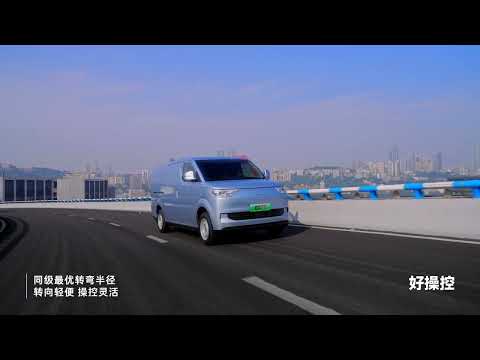Seres Ruichi EC75 Video Review
The Seres Ruichi EC75 offers a spacious flat-roof design, advanced multi-function steering, a 10.1-inch central control screen, and a 95 kW motor. Enjoy a range of 310 km, 80 km/h top speed, and a 42 kWh battery. Perfect for efficient cargo transport with 1200 kg capacity.
What is the Seres Ruichi EC75?
The Seres Ruichi EC75 is a purpose-built electric cargo van from Seres, a sub-brand of Dongfeng Motor Group. Launched in 2023, it's designed for inner-city deliveries and short-haul logistics. With a 310 km (192 miles) range, 1200 kg (2645 lbs) payload, and a 95 kW (127 hp) motor under the hood, this EV van proves you don’t need to spend big to go green. At a starting price of $23,000 (around €21,160 or £18,400), it’s punching well above its class in value and functionality for delivery businesses, tradespeople, and fleet managers.
310 km Range and 1200 kg Payload: Built for the Daily Grind
If your workday means drop-offs across the city, the EC75’s 310 km (192 miles) of range means you're covered. Thanks to a 42 kWh LFP battery, it keeps going without guzzling fossil fuels or racking up maintenance bills. It hauls up to 1200 kg (2645 lbs) in a 6.7 cubic meter cargo area—more than the Nissan e-NV200 and Renault Kangoo Z.E. That makes it ideal for food delivery, parcel distribution, or moving gear between job sites. It’s also got the right-sized body: 5130 mm long and 1860 mm wide, making it maneuverable enough for tight urban streets but big enough to carry serious cargo.
Smart Charging and Real-World Efficiency
Charging the EC75 is simple and efficient. A full charge via Level 2 AC takes about 8 hours—perfect for overnight depot setups. Need a quick top-up? A fast-charging option (on the 50.1 kWh variant) gets you from 20% to 80% in just 18 minutes. With electric energy costing a fraction of diesel or gas, and minimal maintenance required for LFP batteries, the EC75 cuts operating costs significantly. That makes it more than just an eco choice—it’s a smart financial move for fleet operators watching every cent.
Comparing the EC75 to e-NV200, BYD T3, Maxus EV80, and Kangoo Z.E.
Let’s stack it up. The EC75 edges out the Nissan e-NV200 on power (95 kW vs 80 kW), range (310 km vs 200 km), and payload (1200 kg vs 705 kg). It also beats the Renault Kangoo Z.E.’s 270 km and 650 kg specs. The BYD T3 comes close with a 300 km range, but fewer tech features. Maxus EV80 leads with a 320 km range and 1500 kg payload, but starts closer to $35,000. At $23,000, the EC75 finds a sweet spot: it delivers where it matters most—range, load, and price—without the extra fluff or inflated price tag.
Interior and Tech: Utility Meets Intelligence
Hop into the EC75’s cabin and you’ll find a work-focused yet modern layout. The fabric seats are 4-way adjustable, and the 10.1-inch touchscreen handles media, navigation, and rear camera feed. The full LCD dashboard gives real-time battery status and speed data. You get an electronic handbrake, a modern gear shift lever, and—get this—a cloud-based battery management system (BMS). Optional features like L2 driving aids (lane departure, adaptive cruise control) help minimize driver fatigue. This isn’t a barebones shell—it’s a connected work pod that respects both comfort and function.
Built for Fleets: Affordability Meets Durability
With a price tag of $23,000 (€21,160 / £18,400), the EC75 is tailor-made for businesses looking to go electric without draining the budget. Whether you’re a local courier service or a tradesman moving supplies, this van offers a durable steel frame, rear-wheel or front-wheel drive options, and urban agility. Its low ground clearance and flat-roof profile make for better aerodynamics, helping the battery stretch every kilometer. The 180° flat tailgate and extra-wide sliding doors (1014 mm opening) make loading a breeze, even on narrow curbs or busy streets.
Why the EC75 Makes Business Sense in 2025
As emissions rules tighten and fuel prices yo-yo, the EC75 futureproofs your business. It lets you deliver in low-emission zones without penalties, promotes your green credentials, and drops operational costs across the board. Dongfeng’s after-sales support includes spare parts access and video guides—important for fleet operators. With right-hand drive models and expansion to markets like Russia and Southeast Asia, Seres is clearly thinking global. And for those eyeing even more range, there’s a 52.16 kWh variant priced from $13,400 for regional fleets with heavier logistics loads.
Conclusion
Pros and Cons of the Seres Ruichi EC75
- 310 km (192 mi) range ideal for full-day urban operations
- 1200 kg (2645 lbs) payload capacity for logistics work
- Quick charging: 20–80% in 18 minutes (on select trims)
- Affordable price at $23,000 (€21,160 / £18,400)
- Smart features like 10.1" touchscreen and optional L2 ADAS
- Top speed capped at 80 km/h (50 mph)—not for highway fleets
- Less brand recognition outside China
- No AWD option
- Interior prioritizes utility over refinement
- Not yet widely available globally
Final thoughts
The Seres Ruichi EC75 is a business-first electric van delivering the essentials—range, load capacity, and affordability—without fluff. For urban logistics teams seeking a zero-emission solution under $25K, it’s the smart buy that pays itself off quickly.








